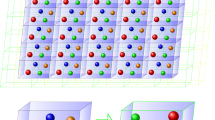Abstract
The relevant relations pertaining to thermo-hyperelastodynamics are developed in spatial and material setting. These are besides the kinematics essentially the appropriate formulations of the balance of momentum and the resulting balance of kinetic energy for the mechanical part and the balances of energy and entropy for the thermodynamical part. The attempt is here to mirror the thermodynamics underlying the spatial setting by the corresponding thermodynamics of the material setting. Thus a number of interesting and new relations between the two settings or rather motion problems, that would have been overlooked otherwise, are discovered. Summarizing, the main aim of this work is twofold: on the one hand to highlight the intriguing duality of the spatial and the material setting of thermo-hyperelastodynamics and on the other hand to provide the necessary tools for an elegant transition between these two settings. Thereby, the underlying strong interest of the material setting rests in particular in the interpretation of the corresponding material forces as the thermodynamical driving quantities for the motion of general defects relative to the ambient material.
Similar content being viewed by others
References
R.C. Batra, The force on a lattice defect in an elastic body. J. Elasticity 17 (1987) 3–8.
P. Chadwick, Applications of an energy-momentum tensor in non-linear elastostatics. J. Elasticity 5 (1975) 249–258.
C. Dascalu and G.A. Maugin, Material forces and energy-release rate in homogeneous elastic solids with defects. C. R. Acad. Sci. Paris II 317 (1993) 1135–1140.
C. Dascalu and G.A. Maugin, The thermoelastic material-momentum equation. J. Elasticity 39 (1995) 201–212.
M. Epstein and G.A. Maugin, The energy-momentum tensor and material uniformity in finite elasticity. Acta Mechanica 83 (1990) 127–133.
M. Epstein and G.A. Maugin, Thermoelastic material forces: Definition and geometric aspects. C. R. Acad. Sci. Paris II 320 (1995) 63–68.
M. Epstein and G.A. Maugin, Thermomechanics of volumetric growth in uniform bodies. Internat. J. Plasticity 16 (2000) 951–978.
J.L. Ericksen, Special topics in elastostatics. Adv. in Appl. Mech. 17 (1977) 184–224.
J.L. Ericksen, Remarks concerning forces on line defects. ZAMP 46 (1995) 247–271.
J.L. Ericksen, On nonlinear elasticity theory for crystal defects. Internat. J. Plasticity 14 (1998) 9–24.
J.D. Eshelby, The force on an elastic singularity. Phil. Trans. Roy. Soc. London A 244 (1951) 87–112.
J.D. Eshelby, The continuum theory of lattice defects. In: F. Seitz and D. Turnbull (eds), Progress in Solid State Physics, Vol. 3, Academic Press, New York (1956) pp. 79–144.
J.D. Eshelby, Energy relations and the energy momentum tensor in continuum mechanics. In: M.F. Kanninen, W.F. Adler, A.R. Rosenfield and R.I. Joffee (eds), Inelastic Behaviour of Solids, McGraw-Hill, New York (1970) pp. 77–115.
J.D. Eshelby, The elastic energy-momentum tensor. J. Elasticity 5 (1975) 321–335.
M.E. Gurtin, On the nature of configurational forces. Arch. Rational Mech. Anal. 131 (1995) 67–100.
M.E. Gurtin, Configurational Forces as Basic Concepts of Continuum Physics. Springer, New York (2000).
R. Hill, Energy-momentum tensors in elastostatics: Some reflections on the general theory. J. Mech. Phys. Solids 34 (1986) 305–317.
R. Kienzler and G. Herrmann, Mechanics in Material Space. Springer, Berlin (2000).
J.E. Marsden and T.J.R. Hughes, Mathematical Foundations of Elasticity. Prentice-Hall, Englewood Cliffs, NJ (1983).
G.A. Maugin, Material Inhomogeneities in Elasticity. Chapman & Hall, London (1993).
G.A. Maugin, Material forces: Concepts and applications. Appl.Mech. Rev. 48 (1995) 213–245.
G.A. Maugin, On the universality of the thermomechanics of forces driving singular sets, Arch. Appl. Mech. 69 (1999) 1–15.
G.A. Maugin and C. Trimarco, Pseudomomentum and material forces in nonlinear elasticity: Variational formulations and application to brittle fracture. Acta Mech. 94 (1992) 1–28.
G.A. Maugin and C. Trimarco, On material and physical forces in liquid crystals. Internat. J. Engrg. Sci. 33 (1995) 1663–1678.
D. Rogula, Forces in material space, Arch. Mech. 29 (1977) 705–713.
R.T. Shield, Inverse deformation results in finite elasticity. ZAMP 18 (1967) 490–500.
M. Šilhavý, The Mechanics and Thermodynamics of Continuous Media. Springer, Berlin (1997).
P. Steinmann, Application of material forces to hyperelastostatic fracture mechanics. Part I: Continuum mechanical setting. Internat. J. Solids Struct. 37 (2000) 7371–7391.
P. Steinmann, On spatial and material settings of hyperelastodynamics. Acta Mech. 156 (2002) 193–218.
P. Steinmann, On spatial and material settings of hyperelastostatic crystal defects. J. Mech. Phys. Solids 50 (2002) 1743–1766.
P. Steinmann, D. Ackermann and F.J. Barth, Application of material forces to hyperelastostatic fracture mechanics. Part II: Computational setting. Internat. J. Solids Struct. 38 (2001) 5509–5526.
Author information
Authors and Affiliations
Rights and permissions
About this article
Cite this article
Steinmann, P. On Spatial and Material Settings of Thermo-Hyperelastodynamics. Journal of Elasticity 66, 109–157 (2002). https://doi.org/10.1023/A:1021233322132
Issue Date:
DOI: https://doi.org/10.1023/A:1021233322132




